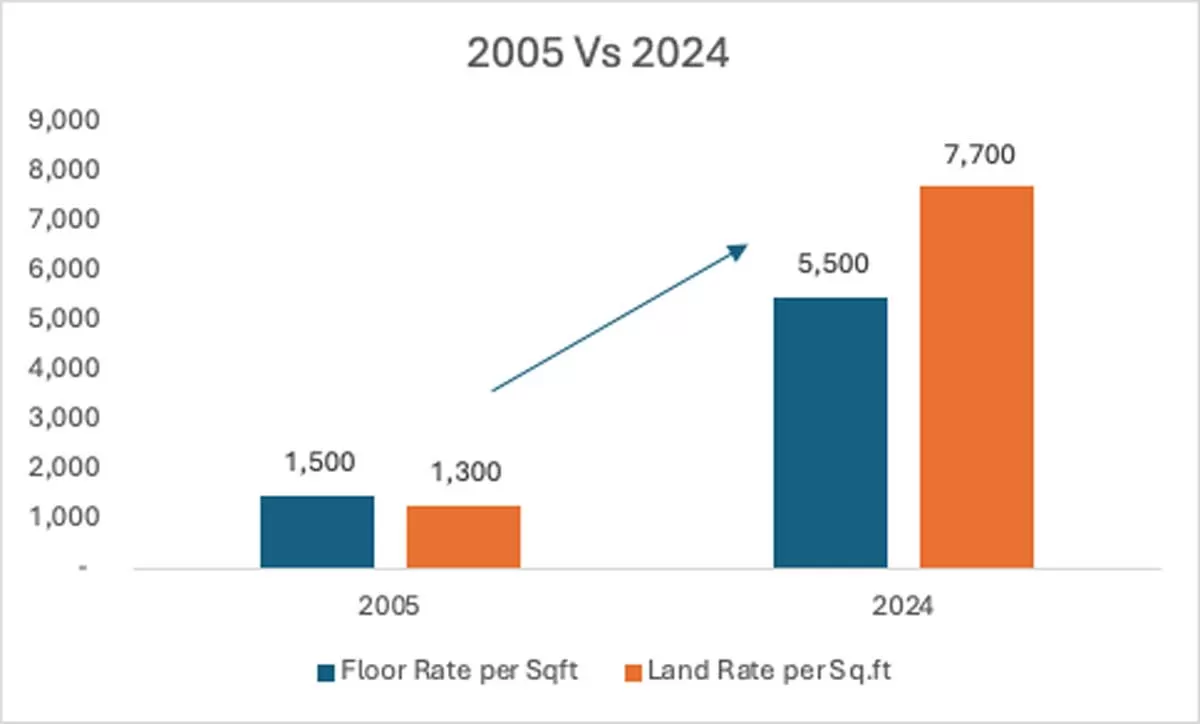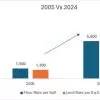After a prolonged dry spell in the roads sector, industry perhaps had high hopes pegged on the resurgence of the build operate transfer-toll (BOT) model against the backdrop of progressive reforms introduced in the PPP framework. The revival of BOT was contemplated based on extensive consultation with stakeholders on the modified concession agreement with a concerted effort to alignit to changed market dynamics. However, with the outbreak of COVID-19, the wait mayhave got a little longer. During the heydays in the later part of last decade and early part of this one, the BOT model shot into limelight as the most preferred mode of awarding new projects in the roads sector, setting a high benchmark for other sectors within the PPP framework.
Also read: NHAI's proposal for operational BOT (Toll) projects
However, subsequently, because of changed market conditions, the quantum of BOT projects awarded dropped from a peak of ~6,150 km in FY2011 to 500 km in FY2019. With private-sector financing taking a backseat, the hybrid annuity model (HAM) and EPC did the catching up with a significant portion (almost 90-95 per cent) of projects awarded from 2014-15 onwards, steadying the pace of road construction under the NDA 1 regime.

Need to relaunch the BOT Model
Based on this evolving trend of BOT taking a backseat,NHAI witnessed its debt balloon by over nine times to Rs 2.28 trillion in the pastfive years,primarily owing to the skewed means of finance that was largely funded by external borrowings. However, with a slowing economy and concerns about its financial health, the pace of construction and award has started to decelerate over the past few quarters. In the first 10 months of FY20 (till January 2020), construction activity has slowed down to 25.9 km/day (April-January) vis-à-vis 29.7 km/day achieved in fiscal 2019. In absolute terms till January-end, total road construction stood at 7,925 km versus 11,000 km targeted for the year. Projects awarded also declined significantly, with less than 35 per cent of the 10,000 km targeted for FY2020 till December 2020.
Considering the challenges involved in terms of managing its liabilities as well as expediting construction, NHAI has been trying to revamp the BOT model to attract participation from the industry and had floated a draft model concession agreement to seek stakeholder comments.
Keeping in mind the risks involved and public interest, infrastructure projects are preferably implemented through PPP for efficient allocation of risk. This is more so in developing economies where capital is scarce andthe need to accelerate development is imperative. The BOT model aims to pass on both the financial and cash flow risk to the private sector from the Government, which aims to achieve its socioeconomic objective without assuming the said risks. Hence, prudent design and construct of a BOT model under the PPP framework is of utmost importance to ensurethe risk-reward ratio is not skewed towards or against any of the parties involved.
Analysis – modified BOT (Version 2.0)
Infrastructure projects have long gestation periods and alignment of the concession period with project cash flows is imperative for the developer, authority and financiers. Ideally, the termof the concession should be project-specific after taking into account the risks associated with the project and envisaged cash flows. Too short a tenure shall result in inadequate returns to the developermaking it unviable, whereasa longer term may lead to windfall gains for the private-sector participant and losses to the exchequer.

Photo: For representational purpose
At present, the draft concession agreement envisages the concession period for a four-lane road project to be 12 years (20 years for six-lane projects) from the appointed date. Considering ~two years of construction, one year of moratorium and one to two years of tail period at the end of concession as provided in the agreement, the entire repayment period would once again get crammed into a seven to eight-year period. This would imply the debt repayment obligation actually dictating project cash flows and not vice-versa—a classic case of the tail wagging the dog. Needless to say, it would lead to stressed cash flows as faced in BOT 1.0, where the maximum door-to-door tenure was 14 years, prior to the 5/25 era. In view of the above, an ideal concession period would be in the realm of 15-20 years, which could allow smoothening of project cash flows to service the debt and the balance for compensating the developer.
Availability of right of way (ROW) is one of the key risks affecting construction. In BOT 1.0, availability of RoW has always been a point of contention and a major factor leading to project delays. The new concession agreement has addressed this to some extent by way of making 90 per cent of RoW available upfront and carving out exceptions so that the developer is not unduly impacted. Moreover, receipt of permits and approvals, which has been a key point of concern for most developers in the past, has also been addressed in the draftmodified concession agreement. These are indeed welcome steps initiated by the authoritythat would lead to improvement in project economics and reduce risks duringthe construction period. Consequently, this lower risk may be priced in the bids submitted by developers for the new projects. However, this may take some time to evolve as the participants would want to look at the performance of the initial few projects awarded under the BOT mode before coming to any conclusion.
Another important metric is the estimation of the total project cost in the concession, which has an implication on termination payments as well as the financing decision/covenants by the lenders. A study conducted by Behavioural Insights, UK, has stated that in the transportation sector, nine out of 10 projects face cost overrun and a significant number face time overrun too. Various research studieshave highlighted the role of cognitive bias,which supposedly playsa role in project planning resulting in planning fallacy owing to an ‘inside view’.This leads not only to underestimation of time but costs and risks involved and affects both the authority planning the project and the developer planning to bid for the project.
One of the ways to overcome the bias would be to undertake an independent study and benchmark it with the cost of similar projects. Further, when the developer has won the bid, a comparative analysis of the cost should be undertaken in case the variance is more than a prescribed tolerance level andif the variance between the top three bids are also more than,say,10-15 per cent. This would also align the cost with the termination payment clause in the concession, which is often a contentious point. While financing the project, the variance inevitably leads lenders to seek recourse to the project sponsor, who in turn prices this into his bid. In addition to the termination clause, the authority has also introduced a foreclosure clause in the concession agreement for terminating the project on a mutually amicable basis. However, there is need for further articulation and clarity on what circumstances shall trigger foreclosure vis-à-vis termination.
Among the other positive changes included in the concession agreement is the introduction of the harmonious substitution clause, which was a long-pending demand from lenders. This will enable lenders to take pre-emptive steps when the first signs of stress start emerging from the developer or sponsor(s) and would hence enable the former to protect their interest and minimise damage to the project/concession.
Moving on to the time available for construction, the reduction in construction timelines to 650 days is expected to pose a challenge and may need some more deliberation. This will entail a higher level of mobilisation on behalf of the contractor and may perhapscurtail participation from bidders, owing to their limited bandwidth, thereby suppressing the competition. Even under HAM projects, the construction period is around 2.5 years. It needs to be examined whether such abridged timelines are indeed maintainable, else the ability to attract participants would be limited and may be detrimental to the project dynamics.It is pertinent to note that whereas in a HAM structure, the developer is incentivised to achieve early completion, in toll projects it is already inbuilt as early completion shall lead to revenues flowing sooner than later.
Once the project commences operations, revenue risk especially in terms of the traffic is the biggest risk faced by it. Under the BOT regime, this is the risk thatis typically passed on to the private sector, which is expected to be better placed in forecasting and managing it. The traffic variability may not only come from other competing roads but other modes of transport like railways, waterways, etc;a change in profile of the users of the roads; or the occurrence of events like demonetisation or a pandemic situation similar to the one we are facing now with COVID-19.
Despite complex traffic forecasting models, managing traffic risk continues to be the most critical piece in the entire BOT jigsaw and an inexact science. As indicated by a World Bank study, traffic estimation error stems from three components: forecasting error, uncertainty and cognitive bias:
Forecasting error emanates from error in surveys while preparing traffic estimates and the inability to generate a coherent response from participants during surveys. This can be because of sampling error, human error, misjudgement, etc.
Uncertainty emanates from unforeseen circumstances, socioeconomic factors, risks associated with lapse of time, etc.
Cognitive bias stems from optimism in outlook, prevailing condition (anchoring effect, availability bias, etc).
When all these combine, there is a cascading effect on the forecast,potentially leading to failure of the project.
One of the impacts is that it may lead to a higher estimation of project cost and higher leverage than project cash flows can actually sustain. From the authority’s perspective, it shall lead to frontloading of costs with very little skin in the game throughout the concession tenure. Though this risk has been partially addressed by having an additional performance security in place (in case of variance in equity of more than 5 per cent from that envisaged by the authority), it still does not address the issue completely. Moreover, this also means disproportionate risk isbeing passed onto project financiers who typically have twice the capital at stake than the developer.
In the absence of a proper risk assessment capability, it is but natural for both the concessionaire and the authority to share the risk. At present, the BOT model provides for quoting a fixed premium by the developer of the project, which is awarded to the highest bidder, and thereby the risk is loaded onto the developer. One way to do the same is to follow a ‘revenue share’ mechanism instead of a fixed upfront or annual premium, which has been implemented in other PPP projects like airports, telecom, etc. Though theoretically, this also exposes the Government/authority to miss the upside potential for a project (i.e. the premium payment is due from the developer irrespective of lower traffic/revenues), it has a detrimental effect on project developers and their financiers as is evident from past experience. Another option could be to prescribe a tolerance band around the baseline traffic estimates. Within this tolerance band, the developer shall bear the risk of a downside (or upside) and any variation beyond the prescribed limits shall lead to the authority sharing the risk (or reward) for any variation.The formula to arrive at the tolerance should be based on averaging the first two to three years of actual traffic and should also take into account assumptions made by H2 and H3 bidders.
Conclusion
The hallmark of any successful PPP project is based on prudent allocation of risks to the party that can handle it more efficiently. In case such a scenario is not possible, it is recommended that the risks be shared between the parties.NHAI should be credited to have come a long way in addressing the shortfalls in earlier version of BOT projects. However, apart fromgetting therisk-reward matrix correct, it is also important to get its timing right.
The recent COVID-19 pandemic has highlighted how a low-probability event can transform into a large eventuality derailing projects—it is indeed a ‘black swan’ event. Undoubtedly, the industry will be looking for compensation from the government under the force majeure provisions for ongoing projects.
However, it shall also have a deep impact on the projects the government proposed to undertake on BOT mode, not only because of the impact on the economy but cognitive biases as these short-term events may have a disproportionately high perceived disruption playing on the minds of stakeholders. While this undermines value for the project proponents, it may also lead to the developers grossly underestimating the upside. Unless the authority and the government are prepared to tone down their expectation significantly in terms of premium expected (in line with subdued market sentiment and current disruption owing to the pandemic), it certainly sounds aspirational to launch BOT 2.0 as of now, wherein the lenders have struggled to fund the most conservative models, including HAM, in a better financing ecosystem over the past couple of years.
About the Authors:
Sandeep Upadhyay, Managing Director -Infrastructure Advisory, Centrum Capital, is responsible for sourcing and executing fundraising and corporate finance advisory deals across the transportation, logistics, conventional and renewable energy sectors. He has around 17 years of extensive experience in investment banking and corporate finance advisory.
Saravanan Iyer, Vice-President-Infrastructure Advisory, Centrum Capital, heads the advisory practice in the transportation and logistics segment. He has around 11 years of experience in the infrastructure advisory space, having successfully concluded several transactions for government and private-sector entities in infrastructure and PPP.
(The views and opinions expressed in this article are those of the authors and do not necessarily reflect the position of Centrum Capital on the subject.)

















